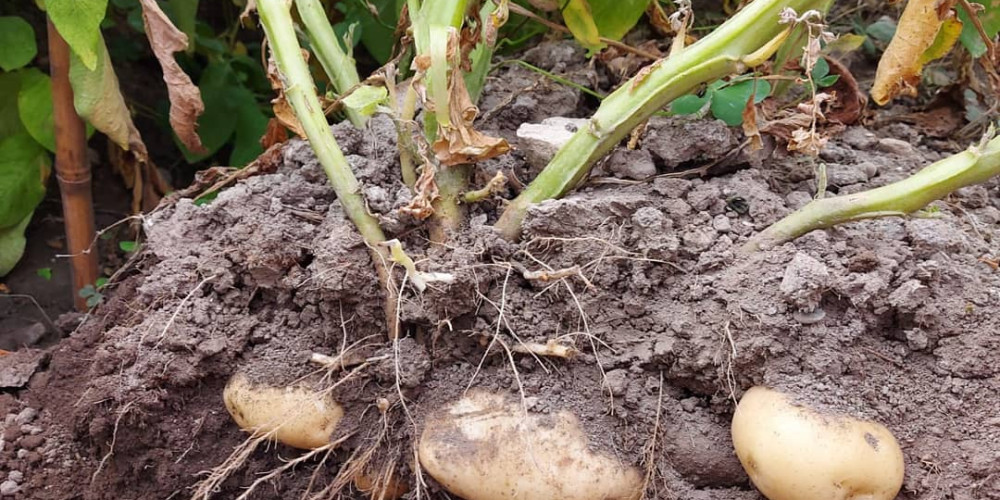Evaluation of Bioiberica's 'Potato Program'
Aim: Evaluation of Bioiberica’s ‘Potato Programme’
Information:
Location: Borja, Zaragoza (Spain)
Crop: Potato (Solanum tuberosum L.)
Variety: Agria
Conditions: Standard growing conditions
Application: Spraying of tubers, soaking well (in the furrow) and the rest is foliar spraying.
Frequency of treatments: BBCH-00 (Terramin® Pro), BBCH-50 (TERRA-SORB® ORGANIC), BBCH-60 (AMINOQUELANT®-K LOW pH)
Evaluation: Weight of each tuber, size distribution, and size separation using commercial parameters.
Treatments:
|
Treat. |
Commercial product |
Dose |
|
1 |
Terramin® Pro (in furrow) |
5 ml/L (5%) |
|
2 |
Terra-Sorb® organic (BBCH-50) |
300 ml/hl |
|
3 |
AminoQuelant®-K low pH (BBCH-60) |
300 ml/hl |
|
4 (Control) |
- |
- |
Methodology:
Treatments
1) First treatment of Terramin® Pro on the day of sowing (14th March) spraying directly along the sowing line.
2) Second treatment done on 28th April in the phenological stage BBCH-35 (Agria) and BBCH-39 (Kennebec). Treatment was carried out with Terra-Sorb® Organic.
3) Treatment in June with AMINOQUELANT®-K LOW pH. Full flowering (BBCH-60) at 3 L/ha.
All treatments were carried out with a 16 L application knapsack sprayer.
Evaluation
The total number of trial lines equalled 28 metres.
Forty plants were sampled for the control, and 40 plants were treated as part of the programme. Of these 40 plants, the size of each tuber was weighed and measured, separating them by: Consumption, Seed and Small Size tubers; a further type of size segmentation was also carried out (>85mm, 85-65 mm, 65-45 mm and <45 mm).
The methodology for evaluating each variety was based on accepted international standards.
Classification by calibre. The harvested tubers were sized by measuring the diameter of each tuber and graded according to size:
- Small size tubers: < to 30 mm
- Seed tubers: 30-70 mm
- Consumption tubers: > 70 mm
Commercial yield (kg/ha). Corresponds to the total production minus tubers below 28 mm in size.
Total yield (kg/ha). This parameter corresponds to the sum of all the calibres.
In addition to international standards methods, a further segmentation of calibres was evaluated, as follows: > 85 mm, 85-65 mm, 65-45 mm and < 45 mm.
Results:
Statistical analysis was used to compare the treatment (control and treated) with the weight and size of the tubers. The study sample consisted of 40 plants.
Yield (kg) Total for 40 plants:
Treated: 53.74 kg. No. of Tubers: 489
Control: 51.61 kg. No. of Tubers: 401
|
Parameter |
Calibre separation 1 |
Calibre separation 2 |
|||||
|
Commercial tuber (> 70 mm) |
Seed Tuber (70-30 mm) |
Small size tuber (< 30 mm) |
> 85 mm |
85-65 mm |
65-45 mm |
< 45 mm |
|
|
Tuber No. (treated) |
125 |
318 |
46 |
22 |
135 |
165 |
167 |
|
Tuber No. (control) |
108 |
258 |
35 |
27 |
106 |
149 |
119 |
Conclusions:
Significant weight differences were obtained in the segmentation of sizes 1 and 2 for the commercial size above 70 mm and the ranges between 70-30, 85-65 and 65-45. The significance has been favourable for the controls, but the production reality is that the biostimulation programme produced more tubers within these ranges than the control, so the improvement in overall production is due to the greater production of tubers. Specifically, the biostimulation programme has increased the number of tubers in the sample of 40 plants, as follows:
- Segmentation 1
- Calibre > 70 increase in 17 tubers
- Calibre 70-30 increase in 60 tubers
- Segmentation 2
- Calibre 85-65 increase in 29 tubers
- Calibre 65-45 increase in 16 tubers
This increase in the number of Agria variety tubers is what determines the increase in final production, the difference being 2.13 kg in 40 plants which is equivalent to 2,128 kg/ha with a density of 40,000 pl/ha.

